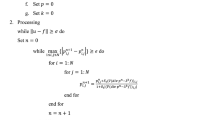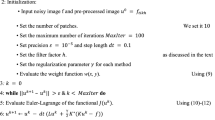Abstract
Confirmation of the integrity of welded pipes is of critical importance in the oil and gas industry and radiography testing (RT) is used as the gold standard for non-destructive testing (NDT) inspection. Radiography is based on the penetration of X-rays or gamma-rays through the object and the measurement of the intensity of the traversing radiation. Unfortunately, intrinsic to the measurement is the undesired detection of scattered radiation which constitutes the imaging noise and manifests in image blurriness. Seamless detection of the presence and evaluation of weld defects necessities high testing sensitivity which requires the selective removal of the blurring and enhancement of the imaging contrast. Software-based removal of the blurriness is achievable by estimation of a “blur kernel” and data processing using various methods. Two such methods that are widely used include the “fast \({{\ell }_{0}}\)” regularized kernel estimation (\({{\ell }_{0}}\)-RKE) and a modification of the Goldstein–Fattal method (MGFM). In the study reported here, the \({{\ell }_{0}}\)-RKE and the MGFM methods were implemented and applied to the radiographs of welded pipes. Improvement of defect region and weld root evaluation was achieved using these methods through the sharpening of the radiograph feature edges/detail. Comparison with the unaided evaluation of the original blurred radiographs by expert operators confirmed the improved visualization for both algorithms. Although the \({{\ell }_{0}}\)-RKE algorithm enhanced the image to a greater extent than the MGFM method, the MGFM algorithm was much faster with run-times of almost half of those for the \({{\ell }_{0}}\)-RKE algorithm.






Similar content being viewed by others
REFERENCES
Nondestructive Testing Handbook, Vol. 3, Radiographic Testing (RT), Columbus: Am. Soc. Nondestr. Test. (ASNT), 2019, 4th ed.
Ajmi, C., Zapata, J., Martínez-Álvarez, J.J., Doménech, G., and Ruiz, R., Using deep learning for defect classification on a small weld X-ray image dataset, J. Nondestr. Eval., 2020, vol. 39, no. 3, pp. 1–13.
Harara, W., Deposit thickness measurement in pipes by tangential radiography using gamma-ray sources, Russ. J. Nondestr. Test., 2008, vol. 44, no. 11, pp. 796–802.
Saber, S. and Selim, G.I., Higher-order statistics for automatic weld defect detection, Int. J. Software Eng. Appl., 2013, vol. 6, no. 5, pp. 251–258.
Yaping, L. and Weixin, G., Research on X-ray welding image defect detection based on convolution neural network, J. Phys. Conf. Ser., 2019, vol. 1237, no. 3, p. 032005.
Jiachen, W. and Xinfang, W., Detection method of weld defect in X-ray steel tube based on background reconstruction, Comput. Math. Appl., 2018, vol. 27, pp. 245–249.
Zhang, H. and Yu, X., Quantitative analysis method of pipeline defects based on optimized RBF neural network, Sustain. Comput. Inf., 2016, vol. 20, pp. 203–209.
Kasban, H., Zahran, O., Arafa, H., El-Kordy, M., Elaraby, S.M., and Abd El-Samie, F.E., Welding defect detection from radiography images with a cepstral approach, NDT & E Int., 2011, vol. 44, no. 2, pp. 226–231.
Getreuer, P., Total variation deconvolution using split Bregman, Image Process. Online, 2012, vol. 2, pp. 158–174.
Yahaghi, E., Mirzapour, M., Movafeghi, A., Matin Mohammadi, P., and Rokrok, B., FISTA algorithm for radiography images enhancement with background blurring removal, Res. Nondestr. Eval., 2019, vol. 30, no. 2, pp. 80–88.
Movafeghi, A., Mirzapour, M., and Yahaghi, E., Using nonlocal operators for measuring dimensions of defects in radiograph of welded objects, Eur. Phys. J. Plus, 2021, vol. 136, pp. 1–11.
Rudin, L.I. and Osher, S., Total variation based image restoration with free local constraints, Proc. 1st Int. Conf. Image Proces. (Austin, 1994), vol. 1, pp. 31–35.
Xu, L., Shicheng, Zh., and Jiaya, J., Unnatural sparse representation for natural image deblurring, Proc. IEEE Conf. Comput. Vision Pattern Recognit. (Portland, 2013), pp. 1107–1114.
Yahaghi, E., Mirzapour, M., Movafeghi, A., and Rokrok, B., Interlaced bilateral filtering and wavelet thresholding for flaw detection in the radiography of weldments, Eur. Phys. J. Plus, 2020, vol. 135, no. 1, pp. 1–10.
Anger, J., Gabriele, F., and Mauricio, D., Estimating an image’s blur kernel using natural image statistics, and deblurring it: an analysis of the Goldstein–Fattal method, Image Proces. Online, 2018, vol. 8, pp. 282–304.
Goldstein, A. and Raanan, F., Blur-kernel estimation from spectral irregularities, Eur. Conf. Comput. Vision (Florence, 2012), pp. 622–635.
Pan, J. and Zhixun, S., Fast ℓ0 Regularized Kernel Estimation for Robust Motion Deblurring, IEEE Signal Proces. Lett., 2013, vol. 20, no. 9, pp. 841–844.
Anger, J., Gabriele, F., and Mauricio, D., Estimating an image’s blur kernel using natural image statistics, and deblurring it: an analysis of the Goldstein–Fattal method, Image Proces. Online, 2018, vol. 8, pp. 282–304.
EN 12681-1, Founding—radiographic testing—Part 1: Film techniques, 2017.
Author information
Authors and Affiliations
Corresponding author
Ethics declarations
The authors declare that they have no conflicts of interest.
Rights and permissions
About this article
Cite this article
Yahaghi, E., Movafeghi, A. & Mirzapour, M. Welded Pipe Defect Detection Enhancement Using Regularized Kernel Estimation-Based Image Processing in Radiographic Testing. Russ J Nondestruct Test 58, 760–767 (2022). https://doi.org/10.1134/S1061830922080046
Received:
Revised:
Accepted:
Published:
Issue Date:
DOI: https://doi.org/10.1134/S1061830922080046




